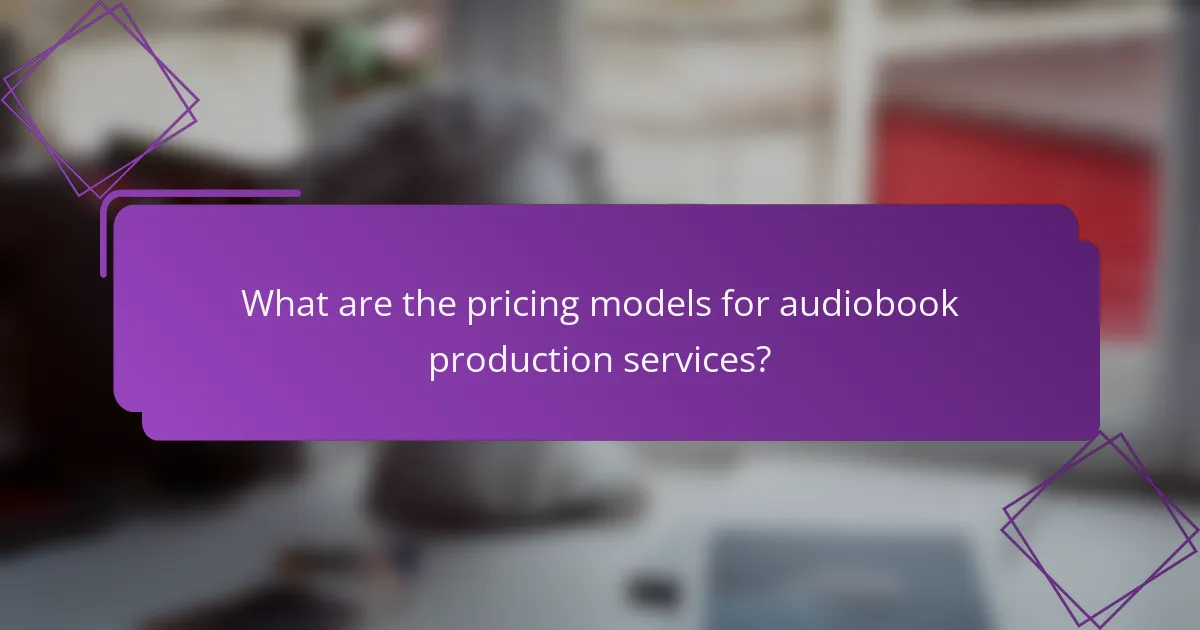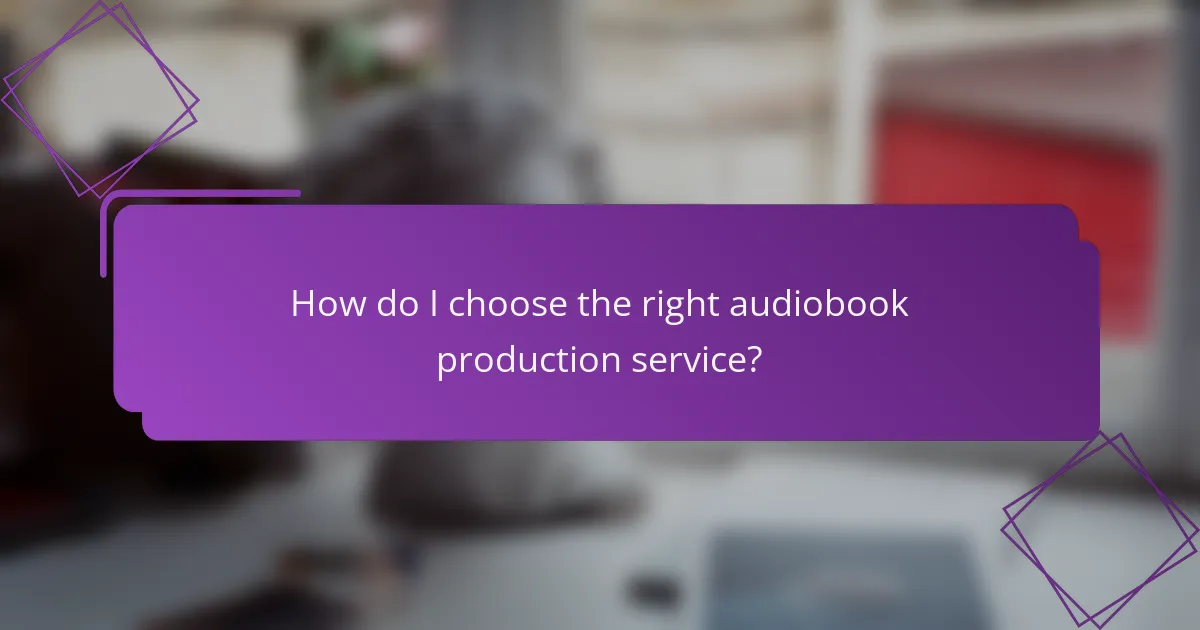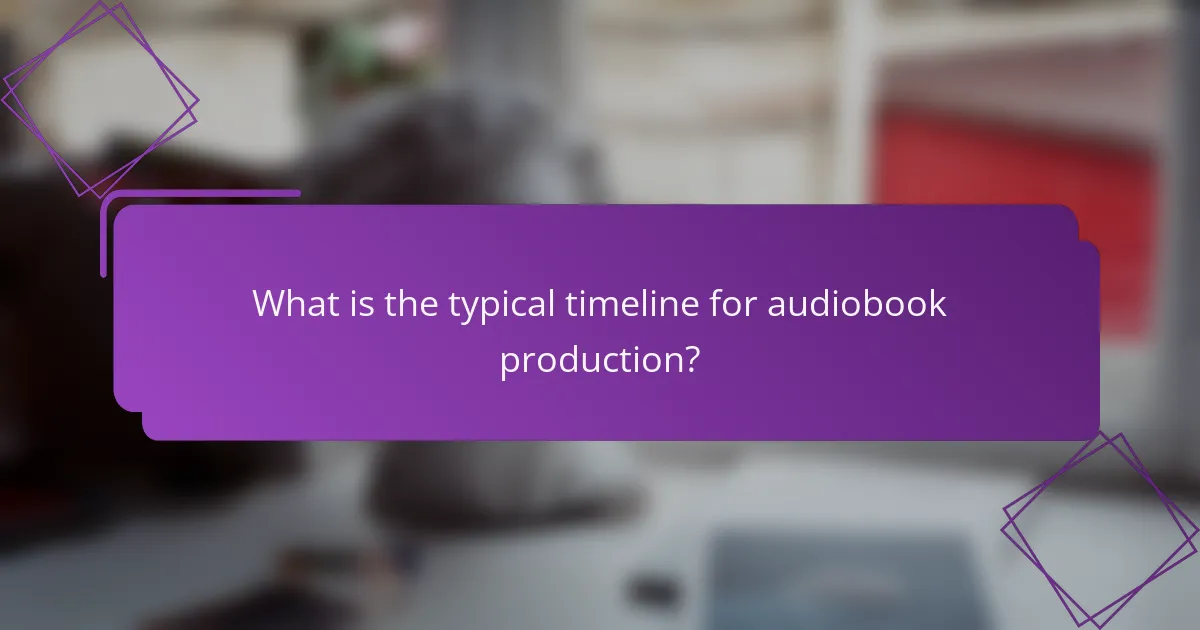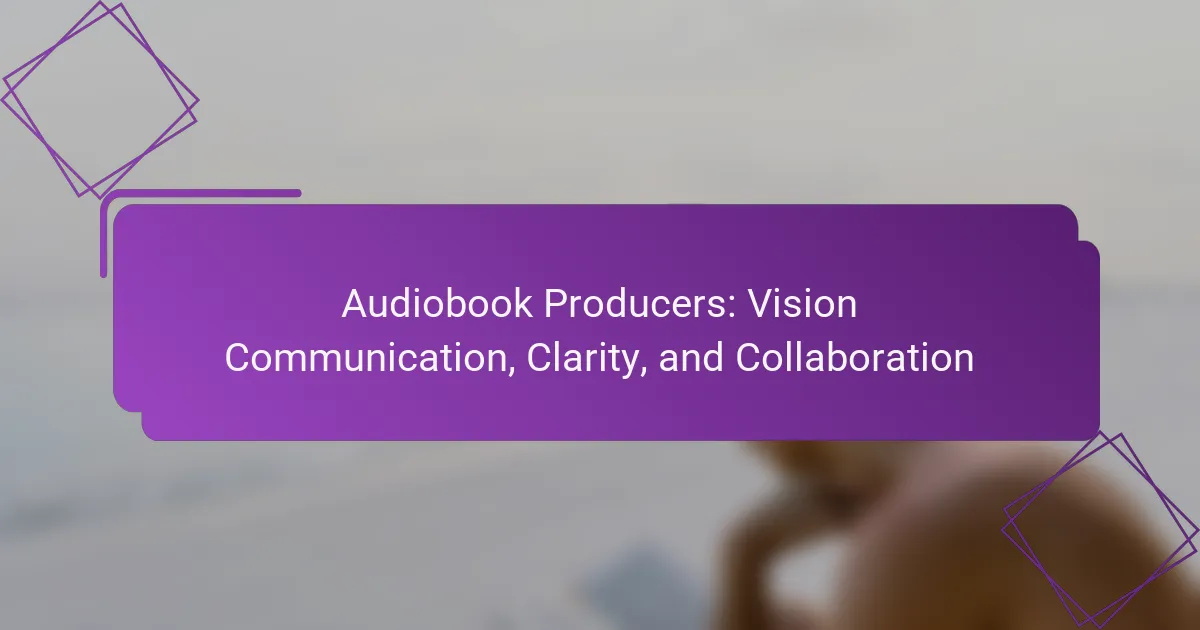Audiobook production services provide various pricing models tailored to meet the diverse needs of authors, publishers, and content creators. By understanding these options, you can select the best fit for your project while considering factors such as quality, timelines, and customer feedback. Key elements like audiobook length, voice talent, and sound editing significantly influence production costs, making it essential to evaluate your budget and requirements carefully.

What are the pricing models for audiobook production services?
Audiobook production services typically offer several pricing models, each catering to different needs and budgets. Understanding these models can help you choose the best option for your project, whether you’re an author, publisher, or content creator.
Flat-rate pricing
Flat-rate pricing involves a fixed fee for the entire audiobook production process. This model is straightforward and allows for clear budgeting, as you know the total cost upfront. Rates can vary widely based on factors such as the length of the book and the experience of the production team, often ranging from a few hundred to several thousand dollars.
When considering flat-rate pricing, ensure that the package includes all necessary services, such as narration, editing, and mastering. This can prevent unexpected costs later in the process.
Per finished hour pricing
Per finished hour pricing charges based on the final length of the audiobook. This model can be beneficial if your project has a variable length, as you only pay for what you get. Rates typically range from around $100 to $400 per finished hour, depending on the quality and experience of the production team.
Keep in mind that the final length can be influenced by editing choices, so it’s wise to have a clear script and plan to minimize costs. This model can lead to higher expenses if the final product ends up being longer than anticipated.
Royalty share agreements
Royalty share agreements involve splitting the revenue generated from audiobook sales between the author and the production team. This model can be appealing for authors with limited upfront funds, as it reduces initial costs. However, it requires a strong marketing strategy to ensure sales, as both parties will benefit from the success of the audiobook.
Before entering a royalty share agreement, clarify the percentage split and any additional costs that may arise. This model may not be suitable for all projects, especially if immediate cash flow is a concern.
Subscription-based models
Subscription-based models allow users to pay a recurring fee for access to audiobook production services. This can be advantageous for authors who plan to produce multiple audiobooks over time, as it often leads to cost savings. Subscription fees can vary, typically starting from around $50 per month.
Evaluate the services included in the subscription, as some plans may offer limited features. This model is ideal for those looking for ongoing support and resources in audiobook production.
Pay-per-project options
Pay-per-project options provide a flexible approach where clients pay for individual audiobook projects as needed. This model is suitable for authors or publishers who may not have consistent production needs. Prices can vary based on project complexity and length, often ranging from a few hundred to several thousand dollars.
When opting for pay-per-project, ensure that you have a clear agreement on deliverables and timelines. This can help avoid misunderstandings and ensure that your project stays on track and within budget.

How do I choose the right audiobook production service?
Choosing the right audiobook production service involves assessing quality, timelines, customer feedback, and service offerings. Prioritize your specific needs, budget, and the level of professionalism you expect from the service.
Assessing service quality
Service quality in audiobook production can be evaluated by examining the expertise of the narrators, the quality of audio equipment, and the overall production process. Look for services that provide samples of their work, showcasing their sound quality and narration style.
Consider whether the service employs professional sound engineers and editors, as this can significantly impact the final product. High-quality services often adhere to industry standards, ensuring clarity and consistency in the audio.
Comparing production timelines
Production timelines can vary widely among audiobook services, typically ranging from a few weeks to several months. When comparing options, inquire about their average turnaround times and any factors that might affect scheduling, such as the length of the book or the complexity of the production.
Some services may offer expedited options for an additional fee, which can be beneficial if you have tight deadlines. Always clarify the expected timeline before committing to avoid surprises later on.
Evaluating customer reviews
Customer reviews are a valuable resource for gauging the reliability and quality of audiobook production services. Look for feedback on platforms like Trustpilot, Google Reviews, or industry-specific forums to get a sense of past clients’ experiences.
Pay attention to recurring themes in reviews, such as communication, adherence to deadlines, and overall satisfaction with the final product. A service with consistently positive reviews is more likely to meet your expectations.
Understanding service offerings
Different audiobook production services offer various packages that may include narration, editing, sound design, and distribution. Assess what each service provides to ensure it aligns with your project needs.
Some services may specialize in specific genres or formats, while others offer comprehensive solutions that cover every aspect of production. Clarifying these offerings upfront can help you choose a service that fits your project scope and budget effectively.

What are the key factors affecting audiobook production costs?
Several key factors influence audiobook production costs, including the length of the audiobook, the selection of voice talent, sound editing requirements, and distribution options. Understanding these elements can help you estimate your budget and make informed decisions throughout the production process.
Length of the audiobook
The length of the audiobook is a primary determinant of production costs. Generally, longer audiobooks require more recording time, which can increase expenses significantly. For example, a typical rate might range from $200 to $500 per finished hour, depending on other factors like voice talent and editing needs.
When planning your audiobook, consider that most listeners prefer works that are concise and engaging. Aim for a length that balances thoroughness with listener attention spans, often between 6 to 10 hours for fiction and 4 to 8 hours for non-fiction.
Voice talent selection
The choice of voice talent can greatly affect the overall quality and cost of your audiobook. Professional narrators may charge varying rates based on their experience and popularity, with fees ranging from $100 to $400 per finished hour. Selecting a voice that resonates with your target audience is crucial.
Consider auditioning multiple voice actors to find the right fit for your content. Look for samples of their previous work to assess their style and delivery. Engaging a well-known narrator can enhance your audiobook’s appeal but may also increase production costs significantly.
Sound editing requirements
Sound editing is essential for ensuring a polished final product, and the complexity of editing required can impact costs. Basic editing, such as removing mistakes and adjusting volume levels, may cost less, while extensive editing, including sound effects or background music, can increase expenses.
On average, sound editing can add anywhere from 20% to 50% to the total production cost. It’s advisable to clearly outline your editing needs upfront to avoid unexpected charges later in the process.
Distribution options
The distribution method you choose for your audiobook can also influence production costs. Platforms like Audible or Google Play may charge fees or take a percentage of sales, impacting your overall budget. Some authors opt for self-distribution to retain more control and profit, but this may require additional marketing efforts.
Evaluate the pros and cons of each distribution option, considering factors like reach, royalties, and ease of use. A well-planned distribution strategy can enhance your audiobook’s visibility while managing costs effectively.

What options are available for audiobook production?
Audiobook production offers various options tailored to different budgets and expertise levels. These include full-service production, DIY tools, and hybrid models that combine elements of both approaches.
Full-service production
Full-service production involves hiring a professional team to handle all aspects of audiobook creation, from narration to editing and mastering. This option is ideal for authors seeking high-quality results without the need to manage the technical details themselves.
Costs for full-service production can vary widely, typically ranging from several hundred to several thousand dollars, depending on the length of the audiobook and the experience of the production team. Authors should consider their budget and the desired quality when choosing this option.
DIY production tools
DIY production tools empower authors to create their own audiobooks using accessible technology and software. Options include recording equipment, audio editing software, and online platforms that guide users through the process.
This approach can significantly reduce costs, often requiring only a few hundred dollars for basic equipment. However, authors must be prepared to invest time in learning the necessary skills and may need to spend additional time on editing and mastering to achieve a professional sound.
Hybrid production models
Hybrid production models blend elements of full-service and DIY approaches, allowing authors to maintain control while still benefiting from professional assistance. For instance, an author might record their narration but hire an expert for editing and mastering.
This model offers flexibility in budgeting and can be a good compromise for those who want to save costs while ensuring quality. Authors should clearly define their roles and responsibilities to avoid confusion and ensure a smooth production process.

What is the typical timeline for audiobook production?
The typical timeline for audiobook production can vary significantly based on the complexity of the project and the resources available. Generally, the entire process can take anywhere from a few weeks to several months, depending on the length of the audiobook and the production team’s efficiency.
Pre-production phase
The pre-production phase involves planning and preparation before recording begins. This includes selecting the narrator, finalizing the script, and determining the overall style and tone of the audiobook. Typically, this phase can take one to three weeks, depending on the project’s scope and the decision-making speed.
During pre-production, it’s crucial to establish a clear timeline and budget. Consider factors such as the narrator’s availability and any necessary revisions to the script. This phase sets the foundation for a smooth recording process.
Recording phase
The recording phase is where the actual narration takes place. This can last from a few days to several weeks, depending on the length of the audiobook and the number of recording sessions required. A common practice is to record in chunks, allowing for breaks and adjustments as needed.
It’s essential to have a professional sound studio for high-quality audio. Ensure that the narrator is comfortable and well-prepared to maintain consistency in tone and pacing. This phase may also involve multiple takes to capture the best performance.
Post-production phase
Post-production involves editing the recorded audio, adding sound effects, and mastering the final product. This phase can take anywhere from one week to several weeks, depending on the complexity of the edits and the length of the audiobook. Key tasks include removing mistakes, adjusting volume levels, and ensuring a polished final product.
During post-production, it’s important to review the audio for quality assurance. Consider hiring a professional audio engineer to enhance the sound quality and ensure compliance with industry standards. This step is vital for delivering a professional audiobook that meets listener expectations.



